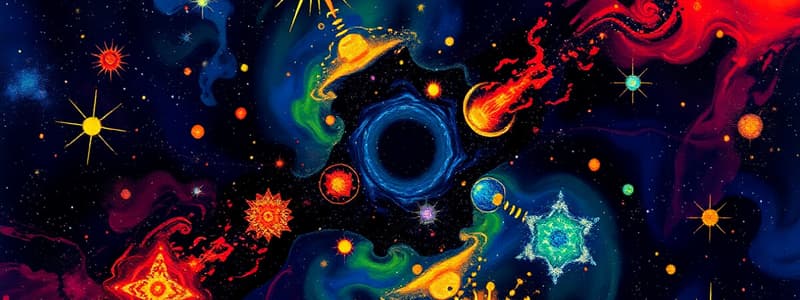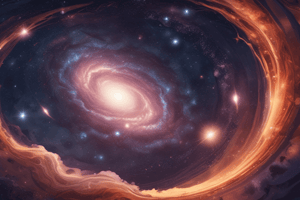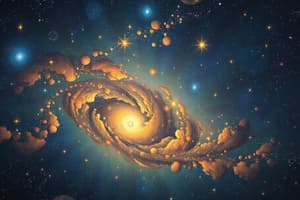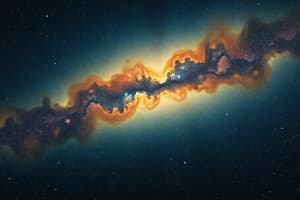Podcast
Questions and Answers
Which is the first stage in the life cycle of a solar mass star?
Which is the first stage in the life cycle of a solar mass star?
- Main sequence star
- White dwarf
- Nebula (correct)
- Protostar
A protostar forms when a white dwarf collapses.
A protostar forms when a white dwarf collapses.
False (B)
What causes a star to become a main sequence star?
What causes a star to become a main sequence star?
Nuclear fusion reactions
After a star enters the red giant stage, it eventually becomes a __________.
After a star enters the red giant stage, it eventually becomes a __________.
Match the following stages of stellar evolution with their descriptions:
Match the following stages of stellar evolution with their descriptions:
What primarily occurs during the red giant phase of a solar mass star?
What primarily occurs during the red giant phase of a solar mass star?
A white dwarf emits a constant amount of energy throughout its lifetime.
A white dwarf emits a constant amount of energy throughout its lifetime.
What happens to a solar mass star after it finishes its life cycle as a white dwarf?
What happens to a solar mass star after it finishes its life cycle as a white dwarf?
Flashcards
Nebula
Nebula
A giant cloud of gas and dust in space where stars are born.
Protostar
Protostar
A hot, dense ball of gas that forms inside a nebula before becoming a star. It is heated and compressed by gravity, but not yet hot enough for fusion.
Main Sequence Star
Main Sequence Star
A star that is undergoing nuclear fusion in its core, converting hydrogen into helium and releasing energy. This stable stage of a star's life is where it spends most of its time.
Red Giant
Red Giant
Signup and view all the flashcards
Planetary Nebula
Planetary Nebula
Signup and view all the flashcards
White Dwarf
White Dwarf
Signup and view all the flashcards
Nuclear Fusion
Nuclear Fusion
Signup and view all the flashcards
Solar Mass Star
Solar Mass Star
Signup and view all the flashcards
Study Notes
Star Formation
- Stars begin as a nebula, a giant cloud of dust and gas.
- Gravity pulls particles in a nebula closer together, forming a protostar.
- Density increases, causing more collisions and higher temperatures within the protostar.
- Protostars eventually become main sequence stars when nuclear fusion reactions start in their cores.
Main Sequence Star
- A main sequence star is stable due to equilibrium between inward gravity and outward pressure from fusion.
- During the main sequence, fusion of hydrogen fuels the star.
Life Cycle of a Solar Mass Star
- After the main sequence, the star becomes a red giant.
- Hydrogen fuel depletes, resulting in weaker outward pressure.
- Fusion of lighter elements to heavier (helium) occurs, causing expansion.
- The star's surface cools, making it red.
- When helium runs out, the star collapses into a white dwarf.
- Eventually, the white dwarf cools down and emits less energy.
- The final stage is a planetary nebula, a glowing cloud of gas ejected from the star.
Studying That Suits You
Use AI to generate personalized quizzes and flashcards to suit your learning preferences.




